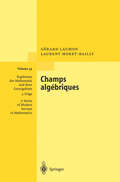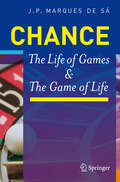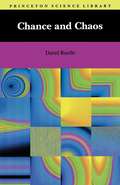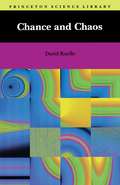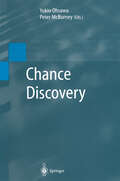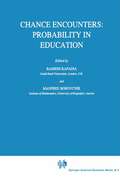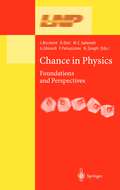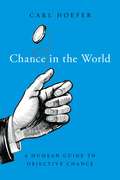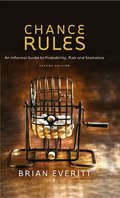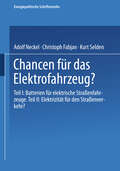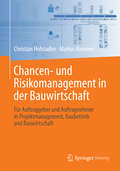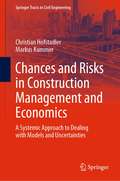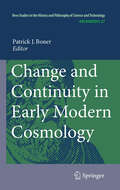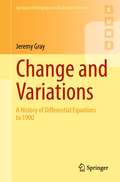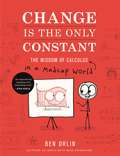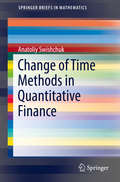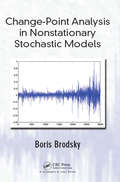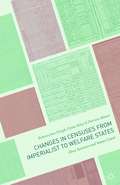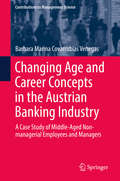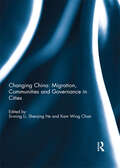- Table View
- List View
Champs algébriques (Ergebnisse der Mathematik und ihrer Grenzgebiete. 3. Folge / A Series of Modern Surveys in Mathematics #39)
by Gérard Laumon L. Moret-BaillyThe theory of algebraic stacks emerged in the late sixties and early seventies in the works of P. Deligne, D. Mumford, and M. Artin. The language of algebraic stacks has been used repeatedly since then, mostly in connection with moduli problems: the increasing demand for an accurate description of moduli "spaces" came from various areas of mathematics and mathematical physics. Unfortunately the basic results on algebraic stacks were scattered in the literature and sometimes stated without proofs. The aim of this book is to fill this reference gap by providing mathematicians with the first systematic account of the general theory of (quasiseparated) algebraic stacks over an arbitrary base scheme. It covers the basic definitions and constructions, techniques for extending scheme-theoretic notions to stacks, Artin's representability theorems, but also new topics such as the "lisse-étale" topology.
Chance: The Life of Games & the Game of Life
by Joaquim P. Marques de SáThis is a unique book on how probability affects our everyday lives. It guides the reader in an almost chronological trip through the fascinating and amazing laws of chance, omnipresent in the natural world and in our daily lives. Along the way many fascinating topics are discussed. These include challenging probability paradoxes, "paranormal" coincidences, game odds, and causes and effects. Finally the author discusses possibilities and limitations of learning the laws of a Universe immersed in chance events. This charming book, with its many easy-to-follow mathematical examples, will inform and entertain the scientist and non-scientist alike.
Chance and Chaos
by David RuelleHow do scientists look at chance, or randomness, and chaos in physical systems? In answering this question for a general audience, Ruelle writes in the best French tradition: he has produced an authoritative and elegant book--a model of clarity, succinctness, and a humor bordering at times on the sardonic.
Chance and Chaos (Princeton Science Library #110)
by David RuelleHow do scientists look at chance, or randomness, and chaos in physical systems? In answering this question for a general audience, Ruelle writes in the best French tradition: he has produced an authoritative and elegant book--a model of clarity, succinctness, and a humor bordering at times on the sardonic.
Chance Discovery (Advanced Information Processing)
by Yukio Ohsawa Peter McBurneyChance discovery means discovering chances - the breaking points in systems, the marketing windows in business, etc. It involves determining the significance of some piece of information about an event and then using this new knowledge in decision making. The techniques developed combine data mining methods for finding rare but important events with knowledge management, groupware, and social psychology. The reader will find many applications, such as finding information on the Internet, recognizing changes in customer behavior, detecting the first signs of an imminent earthquake, etc. This first book dedicated to chance discovery covers the state of the art in the theory and methods and examines typical scenarios, and it thus appeals to researchers working on new techniques and algorithms and also to professionals dealing with real-world applications.
Chance Encounters: Probability in Education (Mathematics Education Library #12)
by ManfredBorovcnik RameshKapadiaThis book has been written to fIll a substantial gap in the current literature in mathemat ical education. Throughout the world, school mathematical curricula have incorporated probability and statistics as new topics. There have been many research papers written on specifIc aspects of teaching, presenting novel and unusual approaches to introducing ideas in the classroom; however, there has been no book giving an overview. Here we have decided to focus on probability, making reference to inferential statistics where appropriate; we have deliberately avoided descriptive statistics as it is a separate area and would have made ideas less coherent and the book excessively long. A general lead has been taken from the fIrst book in this series written by the man who, probably more than everyone else, has established mathematical education as an aca demic discipline. However, in his exposition of didactical phenomenology, Freudenthal does not analyze probability. Thus, in this book, we show how probability is able to organize the world of chance and idealized chance phenomena based on its development and applications. In preparing these chapters we and our co-authors have reflected on our own acquisition of probabilistic ideas, analyzed textbooks, and observed and reflect ed upon the learning processes involved when children and adults struggle to acquire the relevant concepts.
Chance in Physics: Foundations and Perspectives (Lecture Notes in Physics #574)
by J. Bricmont D. Dürr M. C. Galavotti G. Ghirardi F. Petruccione Nino ZanghiThis selection of reviews and papers is intended to stimulate renewed reflection on the fundamental and practical aspects of probability in physics. While putting emphasis on conceptual aspects in the foundations of statistical and quantum mechanics, the book deals with the philosophy of probability in its interrelation with mathematics and physics in general. Addressing graduate students and researchers in physics and mathematics togehter with philosophers of science, the contributions avoid cumbersome technicalities in order to make the book worthwhile reading for nonspecialists and specialists alike.
Chance in the World: A Humean Guide to Objective Chance (Oxford Studies in Philosophy of Science)
by Carl HoeferProbability has fascinated philosophers, scientists, and mathematicians for hundreds of years. Although the mathematics of probability is, for most applications, clear and uncontroversial, the interpretation of probability statements continues to be fraught with controversy and confusion. What does it mean to say that the probability of some event X occurring is 31%? In the 20th century a consensus emerged that there are at least two legitimate kinds of probability, and correspondingly at least two kinds of possible answers to this question of meaning. Subjective probability, also called 'credence' or 'degree of belief' is a numerical measure of the confidence of some person or some ideal rational agent. Objective probability, or chance, is a fact about how things are in the world. It is this second type of probability with which Carl Hoefer is concerned in this volume, specifically how we can understand the meaning of statements about objective probability. He aims to settle the question of what objective chances are, once and for all, with an account that can meet the demands of philosophers and scientists alike. For Hoefer, chances are constituted by patterns that can be discerned in the events that happen in our world. These patterns are ideally appropriate guides to what credences limited rational agents, such as ourselves, should have in situations of imperfect knowledge. By showing this, Hoefer bridges the gap between subjective probability and chance. In a field where few scholars have given adequate treatment to interpreting statements of chance, Hoefer develops a philosophically rich theory which draws on the disciplines of metaphysics, ontology, and philosophy of science.
Chance in the World: A Humean Guide to Objective Chance (Oxford Studies in Philosophy of Science)
by Carl HoeferProbability has fascinated philosophers, scientists, and mathematicians for hundreds of years. Although the mathematics of probability is, for most applications, clear and uncontroversial, the interpretation of probability statements continues to be fraught with controversy and confusion. What does it mean to say that the probability of some event X occurring is 31%? In the 20th century a consensus emerged that there are at least two legitimate kinds of probability, and correspondingly at least two kinds of possible answers to this question of meaning. Subjective probability, also called 'credence' or 'degree of belief' is a numerical measure of the confidence of some person or some ideal rational agent. Objective probability, or chance, is a fact about how things are in the world. It is this second type of probability with which Carl Hoefer is concerned in this volume, specifically how we can understand the meaning of statements about objective probability. He aims to settle the question of what objective chances are, once and for all, with an account that can meet the demands of philosophers and scientists alike. For Hoefer, chances are constituted by patterns that can be discerned in the events that happen in our world. These patterns are ideally appropriate guides to what credences limited rational agents, such as ourselves, should have in situations of imperfect knowledge. By showing this, Hoefer bridges the gap between subjective probability and chance. In a field where few scholars have given adequate treatment to interpreting statements of chance, Hoefer develops a philosophically rich theory which draws on the disciplines of metaphysics, ontology, and philosophy of science.
Chance Rules: An Informal Guide to Probability, Risk and Statistics
by Brian EverittChance continues to govern our lives in the 21st Century. From the genes we inherit and the environment into which we are born, to the lottery ticket we buy at the local store, much of life is a gamble. In business, education, travel, health, and marriage, we take chances in the hope of obtaining something better. Chance colors our lives with uncertainty, and so it is important to examine it and try to understand about how it operates in a number of different circumstances. Such understanding becomes simpler if we take some time to learn a little about probability, since probability is the natural language of uncertainty. This second edition of Chance Rules again recounts the story of chance through history and the various ways it impacts on our lives. Here you can read about the earliest gamblers who thought that the fall of the dice was controlled by the gods, as well as the modern geneticist and quantum theory researcher trying to integrate aspects of probability into their chosen speciality. Example included in the first addition such as the infamous Monty Hall problem, tossing coins, coincidences, horse racing, birthdays and babies remain, often with an expanded discussion, in this edition. Additional material in the second edition includes, a probabilistic explanation of why things were better when you were younger, consideration of whether you can use probability to prove the existence of God, how long you may have to wait to win the lottery, some court room dramas, predicting the future, and how evolution scores over creationism. Chance Rules lets you learn about probability without complex mathematics.
Chancen für das Elektrofahrzeug?: Teil I: Batterien für elektrische Straßenfahrzeuge: Teil II: Elektrizität für den Straßenverkehr? (Energiepolitische Schriftenreihe #6)
by Adolf Neckel Christoph Fabjan Kurt SeldenBereits im Energieplan, den das Bundesministerium für Handel, Gewerbe und Industrie im März 1975 veröffentlicht hat, wurde bei den Möglichkeiten für die Substitution von Energieträgern auf die Elektrotraktion hingewiesen. So heißt es dort im Punkt 18. 2. 3. 3 u. a. : "Im Straßenverkehr in Ballungszentren empfiehlt sich ein erweiterter Ein satz der Elektrotraktion, dem vorläufig durch das ungünstig hohe Lei stungsgewicht der Batterien gewisse Grenzen, vor allem hinsichtlich der Reichweite der Fahrzeuge, gesetzt sind. Verbesserungen werden hier durch die Entwicklung der Zink-Chlorbatterien und später durch den Ein satz von Akkumulatoren mit nicht-wässrigen Elektrolyten erhofft. Nach dem derzeitigen Stand ist nicht anzunehmen, daß der Verbrennungsmotor in den Städten vollkommen substituiert werden kann. Lediglich ein Teil wird auf Elektrotraktion umgestellt werden können . . . . Die Auswirkungen eines erweiterten Einsatzes der Elektrotraktion auf den Ausbau der Er zeugungs-und insbesondere der Verteilungsanlagen für elektrische Energie sind noch eingehend zu prüfen. " Diese Feststellungen stützten sich vornehmlich auf die in Fachpublikatio nen enthaltenen Angaben über Stand und Aussichten der Batterieentwicklung. Diese Angaben waren jedoch teilweise widersprüchlich und in vieler Hin sicht mangelhaft. So wurde es als ein Gebot empfunden, dem Mangel abzuhel fen und die Einschätzung der Chancen der Elektrotraktion auf eine sicherere Basis zu stellen. In dankenswerter Weise hat zunächst das Bundesministerium für Wissenschaft und Forschung durch die Einsetzung eines Projektteams "Elektrochemische Energiespeicherung" eine Bestandsaufnahme nationaler und internationaler Forschungen und Entwicklungen von elektrochemischen Ener giespeichern durchgeführt, deren Ergebnisse von diesem Ressort im Jahr 1976 veröffentlicht wurden.
Chancen- und Risikomanagement in der Bauwirtschaft: Für Auftraggeber und Auftragnehmer in Projektmanagement, Baubetrieb und Bauwirtschaft
by Christian Hofstadler Markus KummerDas Buch befasst sich mit der Kalkulation von Baukosten und Bauzeiten für Auftraggeber und Auftragnehmer in verschiedenen Projektphasen. Am Ende jeder Projekt- und Bauwerksanalyse sind möglichst genaue Angaben zu Zeiten, Kosten und Preisen vorzulegen, die in Abhängigkeit von der Komplexität des Bauobjekts und den Umständen der Leistungserbringung auf einer mehr oder weniger unsicheren Datenbasis stehen. Im Zuge einer Bandbreitenbetrachtung von maßgebenden Inputgrößen kann eine ganzheitliche Perspektive eingenommen werden, wodurch insbesondere Unsicherheiten systematisch Eingang in die Analyse finden. Somit kann die Aussagekraft und Validität konkreter Werte erhöht werden. Durch die Wahl der Bezugsbasis (Werte) wird bestimmt, welche Chancen bzw. Risiken eingegangen werden. Erst die Anwendung probabilistischer Methoden erlaubt die Kalkulation und grafische Darstellung des für die Entscheidungsfindung zentralen Chancen-Risikoverhältnisses.Im Fokus der Betrachtungen steht die systematische Berücksichtigung von Unsicherheiten bei der Ermittlung von Baukosten und Bauzeiten sowie der Lebenszykluskosten. Ergänzend dazu erfolgt eine detaillierte Darstellung anderer Entscheidungsprozesse für die Projektvorbereitung und Planung (Developer-Rechnung, Baugrundanalyse, Kostenschätzung etc.), die Ausführungsvorbereitung (Kosten- und Preisermittlung, Bewertung der Bauzeit, Ressourcenermittlung, Verfahrensvergleich, Angebotsanalyse, Vergabeentscheidung etc.) und die Bauwerksrealisierung (Baulogistik, Verfahrensauswahl, Bauablaufplanung, Leistungsabstimmung, Beschaffung, Mehrkostenermittlung, Trendanalyse etc.) sowie für das übergeordnete Projektportfoliomanagement.
Chances and Risks in Construction Management and Economics: A Systemic Approach to Dealing with Models and Uncertainties (Springer Tracts in Civil Engineering)
by Christian Hofstadler Markus KummerThe book outlines the processes of calculating and critically reviewing construction costs and times for clients and contractors in different project phases. Any project or structural analysis should yield accurate information on times, costs, and prices. The related database is more or less uncertain depending on project complexity and the circumstances of work performance. It is thus recommended to use ranges of key input parameters. This approach consistently considers uncertainties within a holistic project view, thus enhancing the plausibility and validity of specific values. Only the integration of probabilistic methods will allow for calculating and graphically representing the chance/risk ratio as a crucial project variable ultimately influencing the entire business. This book examines the systemic modeling and consideration of uncertainties when determining construction costs and times, and life-cycle costs. It contains detailed descriptions of other decision-making processes, including project preparation and planning (developer calculation, soil survey, cost estimate), work preparation (costing, pricing, construction time evaluation, resource identification, comparison of construction methods, bid analysis, contract award), and project execution (site logistics, construction method selection, construction process planning, work coordination, sourcing, determination of additional costs, trend analyses), as well as for project portfolio management as a tool relevant to all phases.
Change and Continuity in Early Modern Cosmology (Archimedes #27)
by Patrick J. BonerViewed as a flashpoint of the Scientific Revolution, early modern astronomy witnessed a virtual explosion of ideas about the nature and structure of the world. This study explores these theories in a variety of intellectual settings, challenging our view of modern science as a straightforward successor to Aristotelian natural philosophy. It shows how astronomers dealt with celestial novelties by deploying old ideas in new ways and identifying more subtle notions of cosmic rationality. Beginning with the celestial spheres of Peurbach and ending with the evolutionary implications of the new star Mira Ceti, it surveys a pivotal phase in our understanding of the universe as a place of constant change that confirmed deeper patterns of cosmic order and stability.
Change and Variations: A History of Differential Equations to 1900 (Springer Undergraduate Mathematics Series)
by Jeremy GrayThis book presents a history of differential equations, both ordinary and partial, as well as the calculus of variations, from the origins of the subjects to around 1900. Topics treated include the wave equation in the hands of d’Alembert and Euler; Fourier’s solutions to the heat equation and the contribution of Kovalevskaya; the work of Euler, Gauss, Kummer, Riemann, and Poincaré on the hypergeometric equation; Green’s functions, the Dirichlet principle, and Schwarz’s solution of the Dirichlet problem; minimal surfaces; the telegraphists’ equation and Thomson’s successful design of the trans-Atlantic cable; Riemann’s paper on shock waves; the geometrical interpretation of mechanics; and aspects of the study of the calculus of variations from the problems of the catenary and the brachistochrone to attempts at a rigorous theory by Weierstrass, Kneser, and Hilbert. Three final chapters look at how the theory of partial differential equations stood around 1900, as they were treated by Picard and Hadamard. There are also extensive, new translations of original papers by Cauchy, Riemann, Schwarz, Darboux, and Picard. The first book to cover the history of differential equations and the calculus of variations in such breadth and detail, it will appeal to anyone with an interest in the field. Beyond secondary school mathematics and physics, a course in mathematical analysis is the only prerequisite to fully appreciate its contents. Based on a course for third-year university students, the book contains numerous historical and mathematical exercises, offers extensive advice to the student on how to write essays, and can easily be used in whole or in part as a course in the history of mathematics. Several appendices help make the book self-contained and suitable for self-study.
Change Is the Only Constant: The Wisdom of Calculus in a Madcap World
by Ben OrlinThe next book from Ben Orlin, the popular math blogger and author of the underground bestseller Math With Bad Drawings. Change Is The Only Constant is an engaging and eloquent exploration of the intersection between calculus and daily life, complete with Orlin's sly humor and wonderfully bad drawings. Change is the Only Constant is an engaging and eloquent exploration of the intersection between calculus and daily life, complete with Orlin's sly humor and memorably bad drawings. By spinning 28 engaging mathematical tales, Orlin shows us that calculus is simply another language to express the very things we humans grapple with every day -- love, risk, time, and most importantly, change. Divided into two parts, "Moments" and "Eternities," and drawing on everyone from Sherlock Holmes to Mark Twain to David Foster Wallace, Change is the Only Constant unearths connections between calculus, art, literature, and a beloved dog named Elvis. This is not just math for math's sake; it's math for the sake of becoming a wiser and more thoughtful human.
Change Is the Only Constant: The Wisdom of Calculus in a Madcap World
by Ben OrlinThe next book from Ben Orlin, the popular math blogger and author of the underground bestseller Math With Bad Drawings.Change Is The Only Constant is an engaging and eloquent exploration of the intersection between calculus and daily life, complete with Orlin's sly humor and wonderfully bad drawings. Change is the Only Constant is an engaging and eloquent exploration of the intersection between calculus and daily life, complete with Orlin's sly humor and memorably bad drawings. By spinning 28 engaging mathematical tales, Orlin shows us that calculus is simply another language to express the very things we humans grapple with every day -- love, risk, time, and most importantly, change. Divided into two parts, "Moments" and "Eternities," and drawing on everyone from Sherlock Holmes to Mark Twain to David Foster Wallace, Change is the Only Constant unearths connections between calculus, art, literature, and a beloved dog named Elvis. This is not just math for math's sake; it's math for the sake of becoming a wiser and more thoughtful human.
Change of Time Methods in Quantitative Finance (SpringerBriefs in Mathematics)
by Anatoliy SwishchukThis book is devoted to the history of Change of Time Methods (CTM), the connections of CTM to stochastic volatilities and finance, fundamental aspects of the theory of CTM, basic concepts, and its properties. An emphasis is given on many applications of CTM in financial and energy markets, and the presented numerical examples are based on real data. The change of time method is applied to derive the well-known Black-Scholes formula for European call options, and to derive an explicit option pricing formula for a European call option for a mean-reverting model for commodity prices. Explicit formulas are also derived for variance and volatility swaps for financial markets with a stochastic volatility following a classical and delayed Heston model. The CTM is applied to price financial and energy derivatives for one-factor and multi-factor alpha-stable Levy-based models. Readers should have a basic knowledge of probability and statistics, and some familiarity with stochastic processes, such as Brownian motion, Levy process and martingale.
Change Point Analysis for Time Series (Springer Series in Statistics)
by Lajos Horváth Gregory RiceThis volume provides a comprehensive survey that covers various modern methods used for detecting and estimating change points in time series and their models. The book primarily focuses on asymptotic theory and practical applications of change point analysis. The methods discussed in the book go beyond the traditional change point methods for univariate and multivariate series. It also explores techniques for handling heteroscedastic series, high-dimensional series, and functional data. While the primary emphasis is on retrospective change point analysis, the book also presents sequential "on-line" methods for detecting change points in real-time scenarios. Each chapter in the book includes multiple data examples that illustrate the practical application of the developed results. These examples cover diverse fields such as economics, finance, environmental studies, and health data analysis. To reinforce the understanding of the material, each chapter concludes with several exercises.Additionally, the book provides a discussion of background literature, allowing readers to explore further resources for in-depth knowledge on specific topics. Overall, "Change Point Analysis for Time Series" offers a broad and informative overview of modern methods in change point analysis, making it a valuable resource for researchers, practitioners, and students interested in analyzing and modeling time series data.
Change-Point Analysis in Nonstationary Stochastic Models
by Boris BrodskyThis book covers the development of methods for detection and estimation of changes in complex systems. These systems are generally described by nonstationary stochastic models, which comprise both static and dynamic regimes, linear and nonlinear dynamics, and constant and time-variant structures of such systems. It covers both retrospective and sequential problems, particularly theoretical methods of optimal detection. Such methods are constructed and their characteristics are analyzed both theoretically and experimentally. Suitable for researchers working in change-point analysis and stochastic modelling, the book includes theoretical details combined with computer simulations and practical applications. Its rigorous approach will be appreciated by those looking to delve into the details of the methods, as well as those looking to apply them.
Change-Point Analysis in Nonstationary Stochastic Models
by Boris BrodskyThis book covers the development of methods for detection and estimation of changes in complex systems. These systems are generally described by nonstationary stochastic models, which comprise both static and dynamic regimes, linear and nonlinear dynamics, and constant and time-variant structures of such systems. It covers both retrospective and sequential problems, particularly theoretical methods of optimal detection. Such methods are constructed and their characteristics are analyzed both theoretically and experimentally. Suitable for researchers working in change-point analysis and stochastic modelling, the book includes theoretical details combined with computer simulations and practical applications. Its rigorous approach will be appreciated by those looking to delve into the details of the methods, as well as those looking to apply them.
Changes in Censuses from Imperialist to Welfare States: How Societies and States Count
by Dylan Riley Rebecca Jean Emigh Patricia AhmedChanges in Censuses from Imperialist to Welfare States , the second of two volumes, uses historical and comparative methods to analyze censuses or census-like information in the United Kingdom, the United States, and Italy, starting in England over one-thousand years ago.
Changes in Work and Family Life in Japan Under COVID-19 (SpringerBriefs in Population Studies)
by Shigeki Matsuda Hirohisa TakenoshitaThis book describes how the COVID-19 pandemic has affected the way of work, the division of household labor, and family formation in Japan. One of the characteristics of Japanese employment practices is a stable employer–employment relationship and seniority-based wage system. In return, long working hours, especially for men who are called “salarymen” (salaried workers, or “company men”), are required. The pandemic has led to an expansion of telework and has reduced their working hours, which has made them return to their homes to work. In contrast, non-regular employees, who are mostly women, has become more unstable in employment and their incomes fell. This tendency has become even stronger under the pandemic.Compared with conditions in Western countries, in Japan wives have a greater responsibility for domestic chores. In the pandemic, as children's classes shifted to online and childcare support facilities were temporarily closed, the burden of housework and child-rearing increased for wives. However, husbands who worked from home shared a part of the housework, and popular home delivery services helped to reduce the burdens on wives. Japan is one of the developed countries with low fertility rates. Under the pandemic, many Japanese postponed starting a family, which further shrank the country’s birthrate. There was a remarkably significant tendency to postpone having children among economically disadvantaged and socially isolated families. This book provides a portrait of Japan’s experience regarding the notable impacts of the pandemic on work and family life.
Changing Age and Career Concepts in the Austrian Banking Industry: A Case Study of Middle-Aged Non-managerial Employees and Managers (Contributions to Management Science)
by Barbara Marina Covarrubias VenegasDemographic change is affecting societies and organizations alike. Although ageing is relevant to all, there is still a tendency for more negative stereotypes to be attributed to older individuals, while positive stereotypes are mainly associated with younger individuals. Further, there are indications of gendered ageism, showing that age prejudices are more likely to affect women. This book argues that, through holistic measures, human resources management is of fundamental importance to an age-friendly and non-age-discriminatory culture. It can be assumed that awareness-raising on age issues also takes into account the gender issue. Drawing on qualitative interviews with employees in the Austrian banking industry and using an analytical framework, the author provides suggestions and implications for organizations to address this situation.
Changing China: Migration, Communities and Governance in Cities
by Li Li Si-Ming Shenjing Shenjing He Kam Wing ChanChina’s unprecedented urbanization is underpinned by not only massive rural-urban migration but also a household registration system embedded in a territorial hierarchy that produces lingering urban-rural duality. The mid-1990s onwards witnessed increasing reliance on land revenues by municipal governments, causing repeated redrawing of city boundaries to incorporate surrounding countryside. The identification of real estate as a growth anchor further fueled urban expansion. Sprawling commodity housing estates proliferate on urban-rural fringes, juxtaposed with historical villages undergoing intense densification. The traditional urban core and work-unit compounds also undergo wholesale redevelopment. Alongside large influx of migrants, major reshuffling of population has taken place inside metropolitan areas. Chinese cities today are more differentiated than ever, with new communities superimposing and superseding older ones. The rise of the urban middle class, in particular, has facilitated the formation of homeowners’ associations, and poses major challenges to hitherto state dominated local governance.The present volume tries to more deeply unravel and delineate the intertwining forms and processes outlined above from a variety of angles: circulatory, mobility and precariousness; urbanization, diversity and segregation; and community and local governance. Contributors include scholars of Chinese cities from mainland China, Hong Kong, Canada, Australia and the United States. This volume was previously published as a special issue of Eurasian Geography and Economics.
